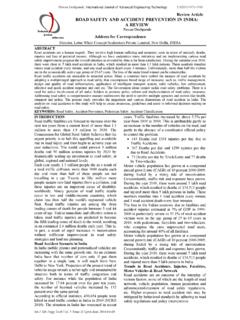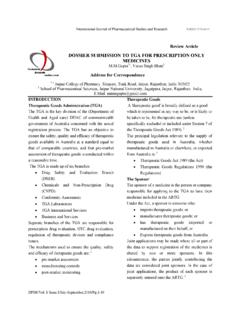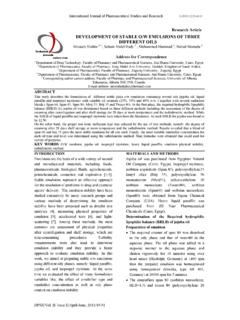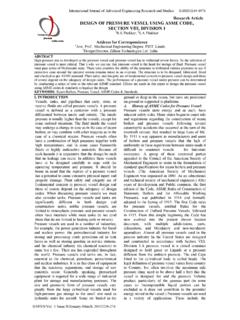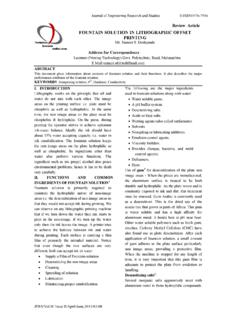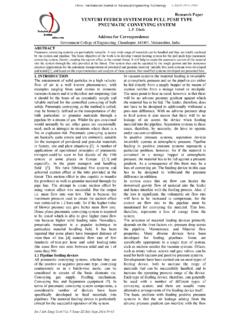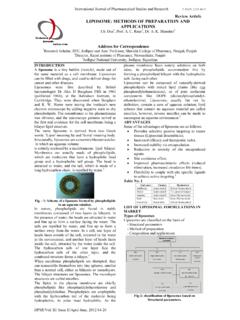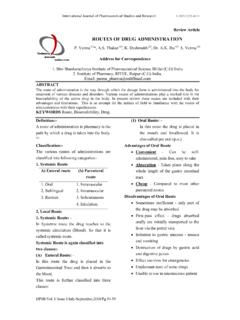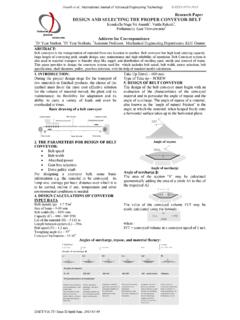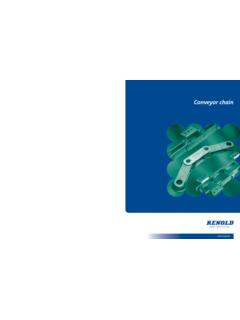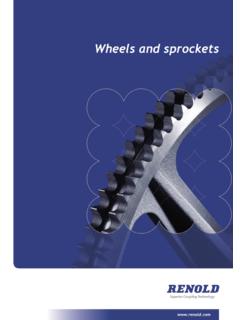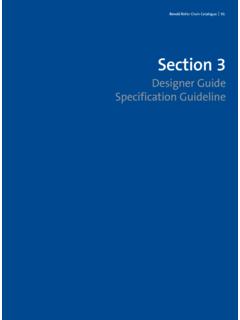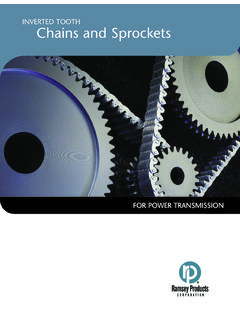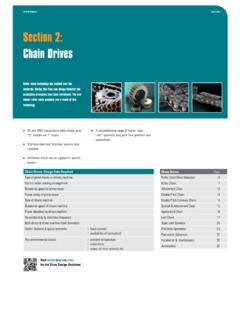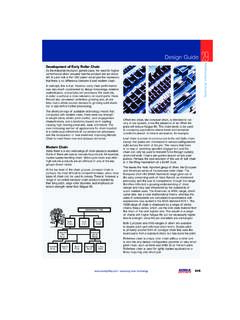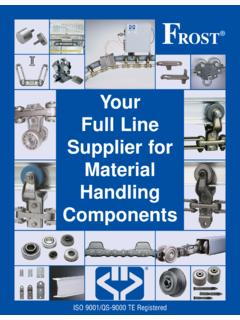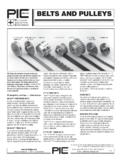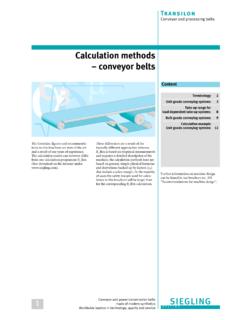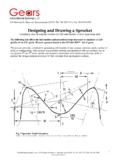Transcription of Research Paper DESIGN AND SELECTING THE PROPER …
1 Ananth et al., International Journal of Advanced Engineering Technology E-ISSN 0976-3945 IJAET/Vol. IV/ Issue II/April-June, 2013/43-49 Research Paper DESIGN AND SELECTING THE PROPER conveyor -BELT Konakalla Naga Sri Ananth1, Vaitla Rakesh2, Pothamsetty Kasi Visweswarao3 Address for Correspondence 1IV Year Student, 2IV Year Students, 3 Assistant Professor, Mechanical Engineering Departments, KLU Guntur ABSTRACT: Belt conveyor is the transportation of material from one location to another. Belt conveyor has high load carrying capacity, large length of conveying path, simple DESIGN , easy maintenance and high reliability of operation.
2 Belt conveyor system is also used in material transport in foundry shop like supply and distribution of molding sand, molds and removal of waste. This Paper provides to DESIGN the conveyor system used for which includes belt speed, belt width, motor selection, belt specification, shaft diameter, pulley, gear box selection, with the help of standard model calculation. 1. INTRODUCTION: During the project DESIGN stage for the transport of raw materials or finished products, the choice of the method must favor the most cost effective solution for the volume of material moved; the plant and its maintenance; its flexibility for adaptation and its ability to carry a variety of loads and even be overloaded at times.
3 Basic drawing of a belt conveyor 2. THE PARAMETERS FOR DESIGN OF BELT conveyor : Belt speed Belt width Absorbed power Gear box selection Drive pulley shaft For designing a conveyor belt, some basic information the material to be conveyed, its lump size, tonnage per hour, distance over which it is to be carried, incline if any, temperature and other environmental conditions is needed. 4. DESIGN CALCULATIONS OF conveyor INPUT DATA Bulk density ( ) T/m3 Size of lump 0-10 mm Belt width (B) 1850 mm Capacity (C) 800 - 900 TPH Lift of the material (H) m Length between centers (L) 29m Belt speed (V) m/s Troughing angle ( ) 350 conveyor Inclination Take Up Travel 600 mm Type of Take up SCREW 5.
4 DESIGN OF BELT conveyor The DESIGN of the belt conveyor must begin with an evaluation of the characteristics of the conveyed material and in particular the angle of repose and the angle of surcharge. The angle of repose of a material, also known as the angle of natural friction is the angle at which the material, when heaped freely onto a horizontal surface takes up to the horizontal plane. Angle of repose Angle of surcharge Angle of surcharge : The area of the section S may be calculated geometrically adding the area of a circle A1 to that of the trapezoid A2. The value of the conveyed volume 1VT may be easily calculated using the formula : where : IVT = conveyed volume at a conveyor speed of 1 m/s Angles of surcharge, repose, and material fluency: Ananth et al.
5 , International Journal of Advanced Engineering Technology E-ISSN 0976-3945 IJAET/Vol. IV/ Issue II/April-June, 2013/43-49 Belt speed: Very high speeds have meant a large increase in the volumes conveyed. Compared with the load in total there is a reduction in the weight of conveyed material per linear meter of conveyor and therefore there is a reduction in the costs of the structure in the troughing set frames and in the belt itself. The physical characteristics of the conveyed material are the determining factor in calculating the belt speed. With the increase of material lump size, or its abrasiveness, or that of its specific weight, it is necessary to reduce the conveyor belt speed.
6 The quantity of material per linear meter loaded on the conveyor is given by the formula: where: qG = weight of material per linear meter Iv= belt load t/h v = belt speed m/s qG is used in determining the tangential force Fu. Maximum speeds advised: Considering the factors that limit the maximum conveyor speed we may conclude: When one considers the inclination of the belt leaving the load point; the greater the inclination, the increase in the amount of turbulence as the material rotates on the belt. This phenomenon is a limiting factor in calculating the maximum belt speed in that its effect is to prematurely wear out the belt surface. The repeated action of abrasion on the belt material, given by numerous loadings onto a particular section of the belt under the load hopper, is directly proportional to the belt speed and inversely proportional to its length.
7 Belt width: The optimum belt speed, the determination of the belt width is largely a function of the quantity of conveyed material which is indicated by the DESIGN of conveyed belt. In practice the choice and DESIGN of a troughing set is that which meets the required loaded volume, using a belt of minimum width and therefore the most economic. Calculation of Belt width: In the following section, the conveyor capacity may be expressed as loaded volume IVT [m3/h] per v= 1 m/sec. The inclination of the side rollers of a transom (from 20 to 45 ) defines the angle of the troughing. Troughing sets at 40 / 45 are used in special cases, where because of this onerous position the belts must be able to adapt to such an accentuated trough.
8 All things being equal the width of the belt at the greatest angle corresponds to an increase in the loaded volume IVT. The DESIGN of the loaded troughing set is decided also as a function of the capacity of the belt acting as a trough. In the past the inclination of the side rollers of a troughing set has been 20 . Today the improvements in the structure and materials in the manufacture of conveyor belts allows the use of troughing sets with side rollers inclined at 30 / 35 . It may be observed however that the belt width must be sufficient to accept and contain the loading of material onto the belt whether it is of mixed large lump size or fine material. In the calculation of belt dimensions one must take into account the minimum values of belt width as a function of the belt breaking load and the side roller inclination as shown.
9 Belt width: volume IM: The volumetric load on the belt is given by the formula: where: Iv = load capacity of the belt [ t/h ] qs = specific weight of the material Also defined as: Where the loaded volume is expressed relevant to the speed of 1 mtr/sec. It may be determined from Tab. 5a-b-c-d, that the chosen belt width satisfies the required loaded volume IM as calculated from the project data, in relation to the DESIGN of the troughing sets, the roller inclination, the angle of material surcharge and to belt speed. Ananth et al., International Journal of Advanced Engineering Technology E-ISSN 0976-3945 IJAET/Vol. IV/ Issue II/April-June, 2013/43-49 Corrects loaded volume in relation to the factors of inclination and feed: In the case of inclined belts, the values of loaded volume IVT [m3/h] are corrected according to the following: IVM = IVT X K X K1 [m3/h] Where: IVM is the loaded volume corrected in relation to the inclination and the irregularity of feeding the conveyor in m3/h with v = 1 m/s.
10 IVT is the theoretic load in volume for v= 1m/s. K is the factor of inclination. K1 is the correction factor given bythe feed irregularity. Ananth et al., International Journal of Advanced Engineering Technology E-ISSN 0976-3945 IJAET/Vol. IV/ Issue II/April-June, 2013/43-49 The inclination factor K calculated in the DESIGN , must take into account the reduction in section for the conveyed material when it is on the incline. Diagram gives the factor K in function of the angle of conveyor inclination, but only for smooth belts that are flat with no profile. Factor of inclination K: In general it is necessary to take into account the nature of the feed to the conveyor , whether it is constant and regular, by introducing a correction factor K1 its value being : K1 = 1 regular feed K1 = irregular feed K1 = most irregular feed.
